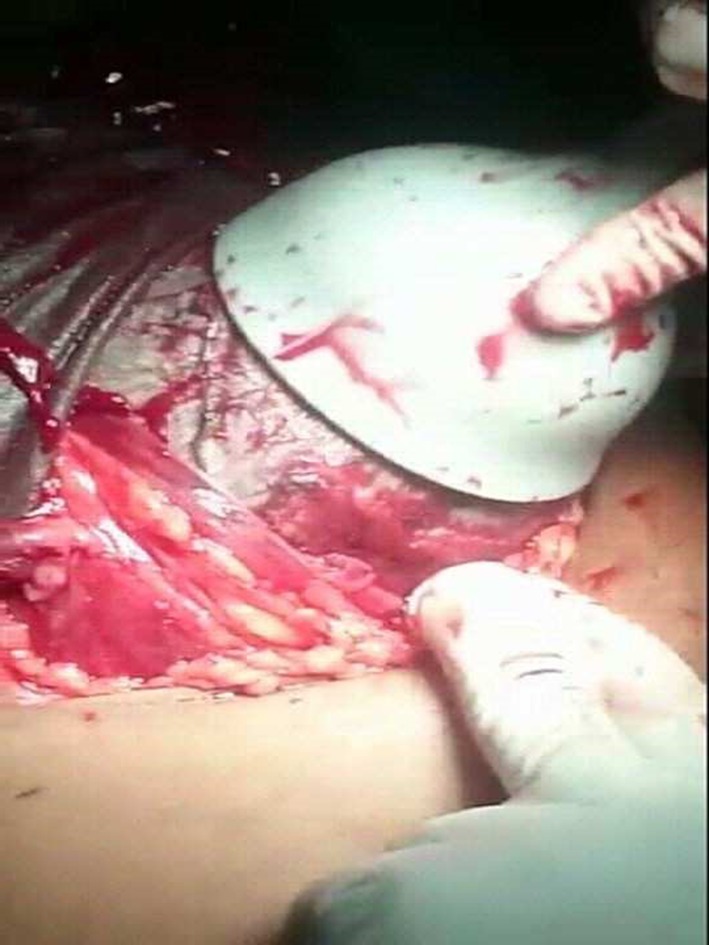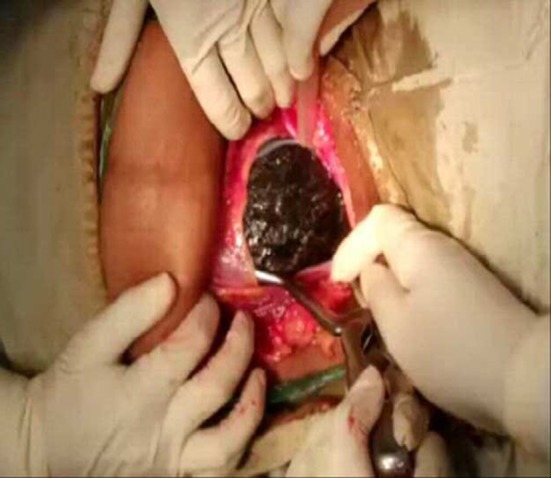Abstract
Cesarean section rate has been on the rise. It is commonly perceived as a simple and safe alternative to difficult vaginal birth. However, there are situations during C section where delivery of fetus may be difficult. This can cause maternal and fetal complications. To avoid such mishaps, anticipation of potential difficulties and planning in advance can be fruitful. This amounts to mobilization of a good team of anesthetist, assistant and skilled neonatologist. Proper technical skills are needed not only to use the equipment but to deal with such situations for safe delivery of the fetus. The training in technical skills can be imparted through drill protocols under C section skills. This way, one should try and accomplish safe atraumatic fetal delivery.
Keywords: Cesarean section, Obstetrician, Fetal
Introduction
Cesarean section is a commonly performed procedure in obstetrics practice. Globally, there is a rising rate of cesarean section [1]. Public perception of C section has swung from “failure of obstetrics care” to “safe for mother and child.” Primary goal of an obstetrician is to do NO HARM. Following rise in primary C section, there is a proportionate rise in repeat C sections as well. One of the major advantages of C section delivery is that the fetal journey through birth canal is eliminated and controlled delivery of the baby under direct vision is accomplished. Paradoxically, there are situations in which the delivery of the fetus is not as smooth and difficult or traumatic delivery would defeat the very purpose for which C section was being performed.
The key to avoid problem and obstetrician’s palpitations is anticipation and planning. One must know when to expect trouble, plan anesthesia, abdominal entry, uterine incision and method of baby delivery keeping all the factors in mind. Adequate knowledge of fetal lie, presentation, station, degree of flexion, position of occiput and placental localization helps to plan the method of delivery. To reduce adverse neonatal outcome, induction delivery interval of more than 8 min and incision delivery interval of more than 3 min should be avoided [2–4].
Why are some C sections difficult?
There are challenges due to the access depending upon the incision taken. Previous abdominal surgery may make it more difficult. Low transverse skin incision is the most commonly used. It can occasionally limit the space available due to inadequate excision of previous surgical scar. Adequate bladder peritoneum dissection is necessary to protect bladder and for proper uterine incision in relation to presenting part. Transverse curvilinear or occasionally J shaped (poorly formed LUS) is essential to maximize the available space. Occasionally, an inverted T shaped or low vertical may have to be taken especially in cases of impacted transverse lie. If taken, then documentation of the same and counseling for an elective C section in future should be done.
Fetopelvic relationships like floating head, deeply engaged head, mal positions like deflexed head, mal presentations like breech and transverse lie, prematurity, multifetal pregnancy, fetal malformations and conjoined twins can create difficult deliveries during C sections. Challenges due to poorly formed LUS as in case of prematurity, fibroids and adhesions in LUS and anterior low-lying placenta are anticipated [5]. Rarely, uterine anomalies like bicornuate uterus with fetus in each horn can also pose a difficulty. In extreme cases, when access to LUS is very difficult, possibility of classical C section should be kept in mind.
Difficult fetal extraction occurs in 1–2% of cases during C section [6].
Delivery of Floating Head
Floating head is difficult to grasp, control and give traction (though one has easy access to it) and it cannot be readily pulled or guided through the incision. Uterine forces do not push the head toward incision, and fundal pressure pushes the head laterally rather than toward the incision or change presentation.
After confirming the findings of floating head, baby is steadied in longitudinal lie by lateral support. After uterine incision, membranes are ruptured slowly to drain the liquor allowing head to descend into the incision site and delivered by maintaining flexion. In case of excess liquor, small incision is taken, liquor is drained slowly by steading the head and then the incision is extended.
The other options are—instrumental delivery by vacuum, forceps or vectis (single blade) [7].
Vacuum After manipulation, vacuum cup (silastic) is applied on area in and around occiput, negative pressure up to 300–400 mm Hg and extraction can be carried out [8] (Fig. 1).
Forceps One forceps blade can be used as lever or both blades (short forceps) can be used to extract head through incision. During forceps blade application, flexion of fetal head is maintained as far as possible with little fundal pressure to push head toward incision. Nuances of forceps application—lower blade of forceps is applied first followed by anterior blade with concavity of pelvic curve towards fetal occiput and then controlled extraction is carried out [9] (Fig. 2). Occasionally, internal podalic version (IPV) can be done and baby can be extracted by footling breech.
Fig. 1.

Vacuum Application at C section
Fig. 2.

Forceps Application at C section
Deeply Engaged Head
One should anticipate such problem and take decision for C section in time. Anesthesia with good relaxation is preferred as there is decreased room for IU manipulation. Failed instrumental delivery makes it more difficult due to further impaction of fetal head. Bladder should be adequately mobilized. Uterine incision is preplanned at a slightly higher level in LUS. The following options are available:
One can gently push the flat of lower hand between fetal head and pubic symphysis and deliver the fetus.
Vaginal disengagement of head with the help of an assistant (push technique) to meet operators hand and then deliver with usual maneuver. The assistant needs to use 3–4 fingers or hand in the form of cup to push to maintain flexion. It is advisable not to use pressure with 1–2 fingers to push as it can cause skull fracture [10].
Modified lithotomy/supine frog leg (Whitmore) also helps.
Reverse breech extraction (Fong/Arulkumaran 1997) [11]—the baby can be extracted by inserting hand, reaching till fundus for feet, grasping both feet (pull method) and then giving traction parallel to axis of leg—body—head (to avoid hyperextension). This extraction can be done, provided there is adequate liquor and enough space. Push v/s pull technique [1]—push technique takes longer time with greater blood loss and there are more chances of vaginal–uterine injuries requiring suturing. However, fetal injury rate is same in both techniques (Robert Barbieri—Jan 2012) [12].
-
In case fetal shoulders are seen (shoulder sign), then assistant can push the shoulders up and surgeon can extract the fetus.
Baby can be delivered by Patwardhan’s maneuver, if fetal back is posterior. One arm followed by same side leg, then other leg followed by other arm and finally the head.
If the back is anterior, then both the arms with shoulders are delivered followed by fetal trunk, then both legs. Baby’s body is turned caudally and head is scooped out. (Modified Patwardhan’s maneuver).
“Fetal Disimpacting system” and “Fetal Pillow” are available in UK. Balloon with basal plate of 11 cm × 4.5 cm is inserted below fetal head vaginally at the time of bladder catheterization. Just before uterine incision, assistant inflates balloon with 180 cc of normal saline. The basal plate flattens and elevates fetal head by 3–4 cm, making it easier to deliver. Balloon is deflated once fetal delivery occurs and is gently removed [13].
Fetal head elevators (Obstetrics spoon/shoe horns) can be used if available.
Occasionally, an inverted T-shaped incision may help.
Breech Presentation
Incision on the uterus should be adequate. Fetal limbs should be manipulated within natural range (movements); trunk should be supported by pelvic girdle to encourage rotation and after coming head of breech can be delivered by Burns Marshall or Mauriceau Smellie Veit’s method or with help of forceps. Preterm breech may be more prone to injury as LUS thick walled, narrow and retractile over relatively large after coming head.
Transverse Lie
This should be done by skilled and experienced surgeon. It is better to anticipate possibility of some problem and ask for help from an experienced assistant prior to starting C section. External cephalic version can be an option if membranes are intact.
Incision on LUS should be liberal. One should feel for fetal back, trace and hold feet, carry out internal podalic version (IPV) and deliver as breech. In case, if baby’s hand comes out, reposit it and trace back from shoulder.
Extreme Low Birth Weight (LBW) babies
The uterus is less distended, and LUS is not properly formed. Hence, myometrium is thick and the area over LUS is smaller. LUS incision is deeper, bloodier, inadequate and hence can lacerate fetus or extend to uterine vessels. Due to small uterus, bowels can come in operative field. The LUS incision should be adequate, and one should be ready to extend if needed. Occasionally, one might have to take an inverted T shaped or in extremely rare case may be a vertical incision. Small fetus with delicate bones and tissues is more prone to injury; hence, fetus should be grasped and extracted gently.
Multifetal Pregnancy
It is very crucial to have proper information about number of fetuses, lie, presentation and position of placenta before C section. Care should be taken to deliver the first baby first followed by other. Occasionally, after delivery of the first baby, Bandl’s or constriction ring may be found then uterine relaxants may have to be used (anesthetist) to facilitate delivery of remaining baby.
Anterior Low-lying Placenta
Here, one should anticipate LUS to be poorly formed and vascular. After incision, fingers are insinuated in the area free of placenta between placenta and uterine wall, membranes are ruptured, fetal parts are accessed and baby is delivered. Rarely, when the whole of anterior LUS is covered with placenta, then placenta is incised and baby is delivered carefully through rapid transplacental access.
Anterior Fibroid
The exact mapping of fibroid just before C section is very important. One should try and take an incision to avoid fibroid as much as possible and deliver the fetus. Very rarely, one might have to go through the fibroid quickly or perform rapid myomectomy and then deliver the fetus or do classical C section to avoid fibroid. It is advisable to follow aggressive prophylactic treatment for postpartum hemorrhage.
Morbidity
Injury to Mother
There is increased incidence of injury to uterus, damage to uterine vessels, laceration and vaginal tear and injury to lower urinary tract.
Fetal Injury
Deep or uncontrolled uterine incision, inappropriate or inadequate uterine incision and hasty or difficult fetal extraction are the major contributing factors for fetal injury [14]. Impacted fetal head leads to increased risk of head lacerations and fracture skull. Injuries to neck, long bones, shoulder fracture, dislocation of nasal cartilage, brachial plexus, spinal cord injury or liver hematoma can also occur. Difficult delivery can lead to asphyxia causing intracranial hemorrhage.
To prevent these mishap, it is advisable to avoid hasty and difficult fetal delivery and an Obstetrician should be well versed with different maneuvers or should take assistance to conduct safe delivery at C section. There is little formal training in handling these difficult situations and hence skills/drills protocols are recommended [15].
Guidelines
To anticipate potential difficulties.
There is paucity of literature on difficult deliveries at C section.
Only case studies, expert opinion or small case series are available.
Resources (personnel or equipment) should be properly mobilized.
Incision should be well planned (skin-abd wall-uterine) and possibility of EXTENSION should be kept in mind.
Sharp dissection for adhesions should be carried out.
One should try and accomplish a traumatic fetal delivery.
One should have good and skilled neonatal support.
Non vi sed arte… (Not by force but by skill…)—Hippocrates This should be followed to have “Healthy Mother and Healthy Baby.”
To conclude with multitude of different health care systems in place, learning and adopting skills for difficult C section are important to reduce the maternal and fetal complications.
Sujata A. Dalvi
She is a Consultant Obstetrician and Gynecologist at Global, Bhatia, St Elizabeth, Ruxmani Lying in and Jain group of Hospitals, Mumbai. She is a Hon Clinical Associate at Nowrosjee Wadia Maternity Hospital and Jagjivan Ram Railway Hospital, Mumbai. She is a visiting Consultant at Cumballa Hill and Breach Candy Hospital. She graduated UG/PG from Seth GS Medical College and KEM Hospital, Parel, Mumbai, and worked as an associate professor and Unit Chief in the Department of Obstetrics and Gynecology at Seth GS Medical College and KEM Hospital till 1995. She is a joint Assistant editor of JOGI (Journal of Obstetrics and Gynecology of India) and member of Managing Council of Mumbai Obstetrics and Gynecology Society since last 11 years.
Compliance with Ethical Standards
Conflict of interest
The author declares that she has no conflict of interest.
Footnotes
Dr Sujata Dalvi (MD, DGO, FCPS) in Hon Clinical Associate—Nowrosjee Wadia Maternity/Jagjivan Ram Railway Hospital, Mumbai.
References
- 1.Chopra S. Disengagement of the deeply engaged fetal head during cesarean section—conventional method versus reverse breech extraction. Rev Lit Rev Artic Clin Mother Child Health. 2016;13(2):239. [Google Scholar]
- 2.Kamat SK, Shah MV, Chaudhary LS, et al. Effect of induction delivery and uterine delivery on Apgar scoring of newborn. J Post Grad Med. 1991;37(3):125–127. [PubMed] [Google Scholar]
- 3.Datta S, Ostheimer GW, Weiss JB, et al. Neonatal effect of prolonged anesthetic induction for caesarian section. Obstet Gynecol. 1981;58(3):331–335. [PubMed] [Google Scholar]
- 4.Caesarian Section: uterine incision to delivery time (query bank): RCOG: ps14/09/2011—https/www.Rcog.org.UK.
- 5.Malhotra N. Difficult C section: slide share: 2016.
- 6.Greenberg J. Harvard Medical School—Management of deeply engaged and floating fetal presentations at cesarean delivery www.uptodate.com Feb 17, 2016.
- 7.Difficulties with Caesarian Section: Primary Surgery, Vol 1, Non trauma, Chapter 10, The surgery of Labor.
- 8.Ross W. McQuivey. Jon E Block: Vacuum Assisted caesarian section: Int J of Women’s Health. 2017;9:151–155. doi: 10.2147/IJWH.S129814. [DOI] [PMC free article] [PubMed] [Google Scholar]
- 9.Sheriar NK et al: Hay’s forceps: reestablishing relevance in modern obstetrics: 1993. [DOI] [PubMed]
- 10.Jennifer B Manning, Mary C Tolecher, Edwin C, et al: Delivery of an Impacted fetal head during Caesarian—A literature review and proposed management algorithm. Obstet Gynecol Surv. 2015;70(11):719–24. [DOI] [PubMed]
- 11.Kadhum T. Head pushing v/s reverse breech extraction for delivery of impacted fetal head during Caesarian section. Kufa Med J. 2009;12(1):200. [Google Scholar]
- 12.Barbieri Robert. Difficult fetal extraction at cesarean delivery: what should you do? OBG Manag. 2012;24(1):8–12. [Google Scholar]
- 13.Singh M, Varma R. Reducing complications associated with deeply engaged head at caesarian section: a simple instrument. Obstet Gynecol. 2008;10(1):38–41. doi: 10.1576/toag.10.1.038.27376. [DOI] [Google Scholar]
- 14.Waterfall H, Grivell RM, Dodd JM. Techniques for assisting difficult delivery at caesarian section. Cochrane Database Syst Rev 2016;31(1):CD004944. doi:10.1002/14651858.CD004944.pub3.. [DOI] [PMC free article] [PubMed]
- 15.Sethuram R, Jamjute P, Kevlingham E. Delivery of deeply engaged head: a lacuna in training. J Obstet Gynaecol. 2010;30(6):545. doi: 10.3109/01443615.2010.491566. [DOI] [PubMed] [Google Scholar]


